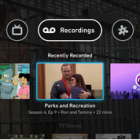Most second-generation products are souped up versions of the originals, but streaming media pioneer Boxee is taking a different approach. On Tuesday, the company announced the Boxee TV, a $99 set-top box with dual tuners that support a $15-a-month cloud-based DVR service with unlimited storage.
With its low price and simple design, Boxee TV clearly targets the mass market that more or less ignored the feature-rich, $199 Boxee Box it replaces. D-Link remains Boxee’s hardware partner for Boxee TV, which is slated to go on sale on November 1. (You can pre-order the device now on Boxee’s website.)
The new hardware is much smaller than the Boxee Box, and its remote has only a few basic navigational and content buttons on one side—it lacks the small keyboard that came on the back of the Boxee Box remote. We’ll have to wait for review units to see how the user interface has evolved.

Boxee TV lets you watch over-the-air or basic cable TV (via a coax connection) and record up to two shows at a time. Through a network connection (either ethernet or Wi-Fi), Boxee TV apps will also stream media from popular Internet sites and services, including Netflix, Vudu, Pandora, YouTube, and Vimeo. (Boxee says that additional media partners will be announced at launch.)
The optional Cloud DVR service will roll out gradually. At launch, it will be available in Atlanta, Chicago, Dallas, Houston, Los Angeles, New York, Philadelphia, and Washington, D.C. While $15 a month may seem expensive, during an in-person demo Boxee CEO and co-founder Avner Ronen said that cable companies typically charge $10 a month extra for cable boxes that record to hard drives with limited capacity. (Boxee will offer a free three-month trial.)

Also, you typically can only access DVR content on the set connected to the DVR, or at best another device on your home network. With Boxee TV, you’ll be able to access your recordings via an HTML 5 app on any Internet-connected device with sufficient bandwidth, which Ronen pegs at between 1.5Mbps and 4Mbps.
While the service will be able to record high-def content, it won’t support adaptive bit rate at launch, meaning it won’t adjust the media stream based on the bandwidth of the receiving device. So you probably won’t be able to watch content on a 3G smartphone, for example.
Asked about the dramatic differences between Boxee TV and the Boxee Box, Ronen said the original product was “designed by geeks for geeks,” while the new one was “designed by geeks for the people.” The goal, he said, is to make Boxee TV and service accessible “to anyone who can pick up a remote.”
We’ll have to wait a few weeks to see if the Boxee TV lives up to that promise.